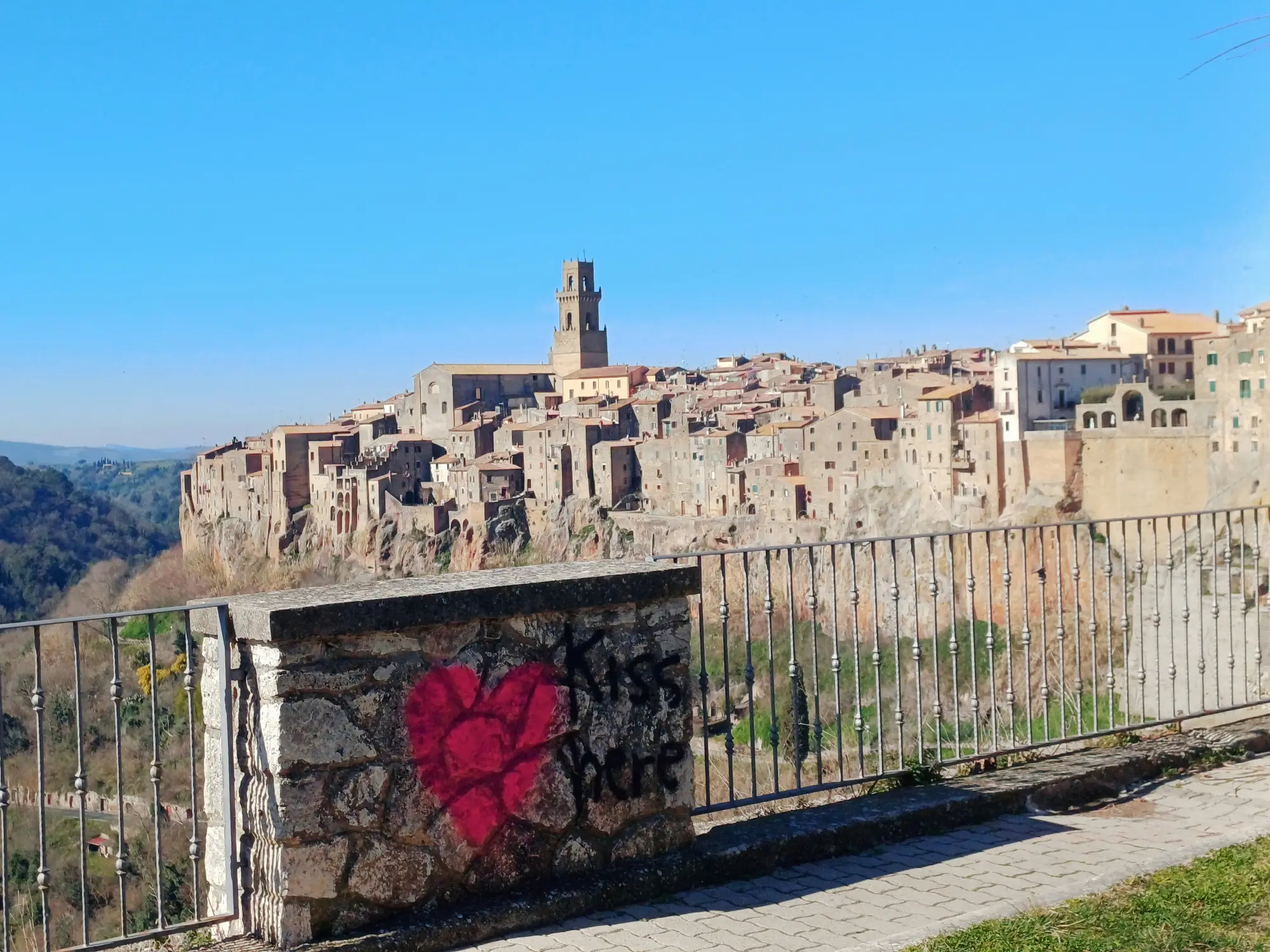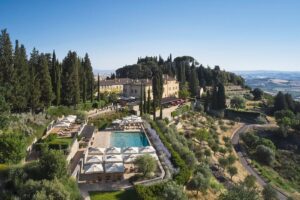Pitigliano: A Town Where Dante, Jerusalem, and Tufo Meet
Disclosure: This page contains affiliate links. If you make a purchase through these links, I may earn a small commission to help me support my blog.📝
Introduction
Imagine a town where one could discover elements of Dante’s Inferno, Etruscan civilization etched on tufo rock and remnants of an important Jewish culture that gave Pitigliano the nickname of “Little Jerusalem.” This town exists: Pitigliano, at the southernmost point of Tuscany, and will charm and amaze visitors alike with its history, beauty, and mystery.
On a sunny winter day, I drove to Pitigliano, a town perched on a cliff of volcanic rock in Tuscany. I followed the Parking sign as soon as I arrived in Pitigliano and walked a narrow road toward the downtown. Was I going the right way? I wondered. Two men appeared, walking in the opposite direction. They looked like they knew the place well. They had friendly faces and warm smiles. I asked them for directions. “Come with us” they said. “We’ll take you there. And we’ll show you around.” They introduced themselves as Cesare and Giorgio, two lifelong friends and residents of Pitigliano. They offered to be my guides for the day, and I gladly accepted.
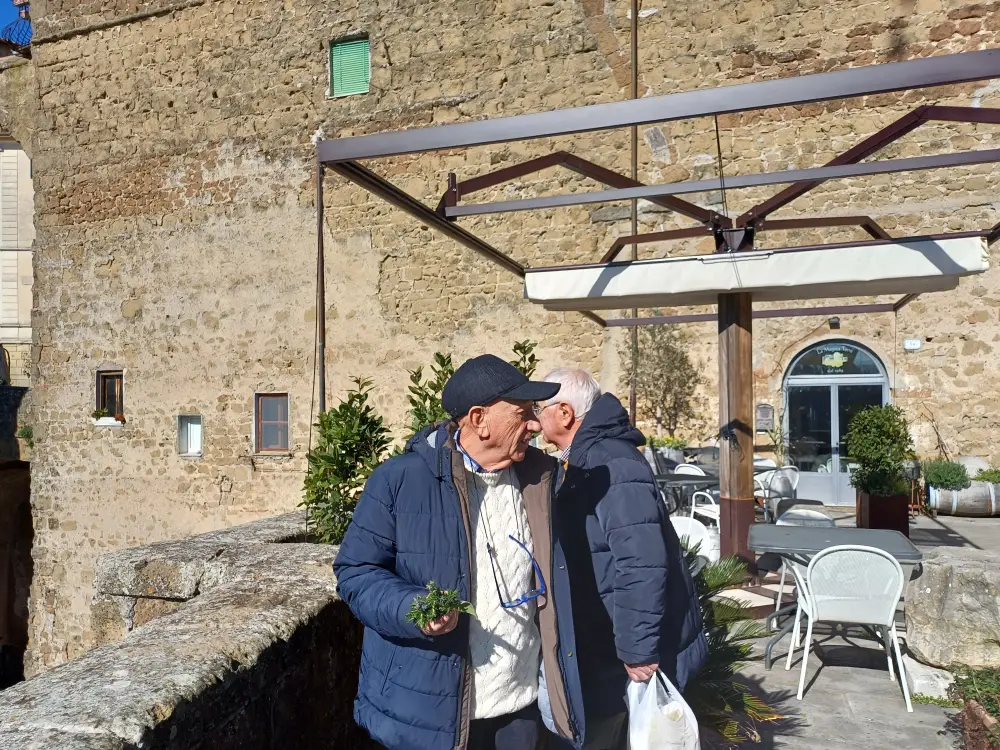
Credit: TuscanDreamVacations.com
They gave me an amazing tour of Pitigliano’s history and culture from ancient to modern times, showing me wells carved into tufo rock where residents collected rainwater while hiding from invaders. I saw the stunning Medici aqueduct, the Orsini fortress, and the beautiful cathedral. Unfortunately, because it was a Saturday, the Synagogue was closed, and I missed it!
They invited me into their underground cantina, where for generations they had been making homemade wine and cheese stored in cool, dark tufo caves. Here I was welcomed with a refreshing glass of Bianco di Pitigliano white wine, one of the most renowned wines from the area.
My gracious hosts also offered me some sfratto, a uniquely shaped sweet pastry with its own history, which I’ll tell you about in a bit. And that is how I met Cesare and Giorgio, two of the kindest, friendliest people I’ve ever met.
Cesare and Giorgio showed me sides of Pitigliano I never would have found on my own and shared their stories and kindness. I now wish to pass those along to you, dear readers! Let’s explore Pitigliano together.
Where is Pitigliano?
Pitigliano is about 132 miles (212 km) west of Florence and can take around two hours and 36 minutes to travel depending on traffic and route conditions.
Certainly! Here’s the revised version of your sentence:
You can reach Pitigliano by car, train, or bus. Once in Pitigliano, you’ll discover nearby charming towns such as Sovana, Sorano, Saturnia, and Orvieto that make this destination truly worth visiting. Consider using Pitigliano as your base to explore these charming areas further, or simply stop by as part of a day trip to appreciate its highlights!
Pitigliano: The Matera of Tuscany
Pitigliano is perched on a cliff made of porous volcanic rock called “tufo.” Pitigliano is often compared to the city of Matera in the region of Basilicata, in southern Italy, which is renowned for its “Sassi,” the cave dwellings that were inhabited for thousands of years and are now a UNESCO World Heritage site.

Credit: TuscanDreamVacations.com
Pitigliano and Matera share many similarities: both were first settled during prehistoric times, both possess an intricate network of underground caves and tunnels used for different purposes, and both boast unique buildings which seem to rise from their surroundings and blend in seamlessly with nature.
How Tufo Shaped Pitigliano
Tufo is a form of volcanic rock, that provides the foundation of Pitigliano and other towns in southern Tuscany known as Tufo Towns.
Tufo has played a crucial part in Pitigliano’s history, culture, and architecture since ancient times. Most buildings in town are made of tufo, and Pitigliano’s famous Vie Cave (Cave Streets) are one of its most striking testimonials of tunnels, dug into the tufo rock by the Etruscans centuries ago and used for trade, communication, and religious ceremonies. They connect Pitigliano with other towns such as Sovana and Sorano. Three of these caves are the most well-known: Via Cava di Fratenuti, Via Cava di San Giuseppe, and Via Cava di San Rocco, among many more!
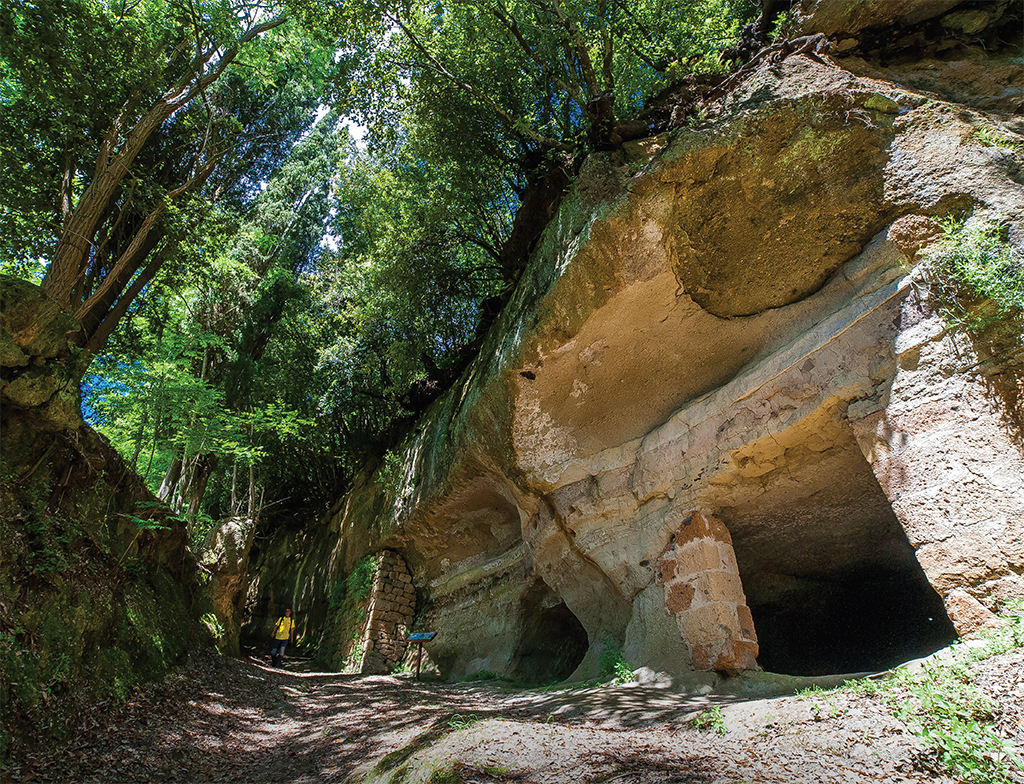
Credit: maremma-magazine.it
Pitigliano’s Tufo heritage includes an intricate network of underground wells and cellars carved by its population from within its rock face, to store food, water, create stable, microclimate, as well as provide protection and survival during wars and sieges. Inhabitants would hide in these wells for extended periods, shielded from danger. Many such wells remain accessible today (just like the one that my guides —Cesare and Giorgio—had showed me! They provide a window into Pitigliano’s history and culture. One particularly interesting well is known as Pozzo della Fortuna, which was constructed during 16th Century with a spiral staircase leading down 25 meters (82 feet)!

Credit: TuscanDreamVacations.com
Tufo comes in yellowish or reddish hues depending on which minerals it contains, giving Pitigliano its cozy warmth.
Tufo is a key feature of Pitigliano’s character and appeal, and makes the town an exceptional tourist destination. When visiting Pitigliano you can admire both its aesthetics and creativity through tufo architecture as well as discover all its mysteries and rich past.
Pitigliano’s History and Jewish Heritage
Did you know that Pitigliano is often referred to as the Little Jerusalem? This charming town has an intriguing past shaped by various cultures and influences over time. Let’s revisit some of its history.
First inhabited by the Etruscans, Pitigliano showcases remnants of their civilization, including vie cave, necropolises, and temples. The Romans, Lombards, and especially the Aldobrandeschi family, who ruled until the 14th century, all played key roles in shaping its destiny and creating Pitigliano as it stands today.
Pitigliano fell under the rule of the Orsini family in 1293 and quickly flourished under their watch. It became a bustling center, with remarkable structures like its fortress, aqueduct, and cathedral being constructed. Perhaps most notably, the Orsini family provided sanctuary to Jewish communities fleeing Papal States and Medici domains. These communities found safe havens in Pitigliano , where they could practice their religion, trade goods, and become integral components of the social fabric. The Jewish residents, even built a synagogue, ritual baths, bakeries, butcher shops, and wine cellars, significantly enhancing Pitigliano’s culture. At one point, it was one of Italy’s largest and most prosperous Jewish communities!
However, upon its incorporation into the Grand Duchy of Tuscany in 1608, Pitigliano saw an end to this situation. The authorities established a ghetto for Jewish inhabitants under orders from the Medici and Pope. Despite this restrictive measure, the Jews of Pitigliano still enjoyed some privileges and freedoms, thanks to the local rulers’ generosity and the Christian majority’s tolerance. The Jewish community contributed significantly to both the economy and culture, through activities such as spice trading, wheat and textiles trading, and money lending.
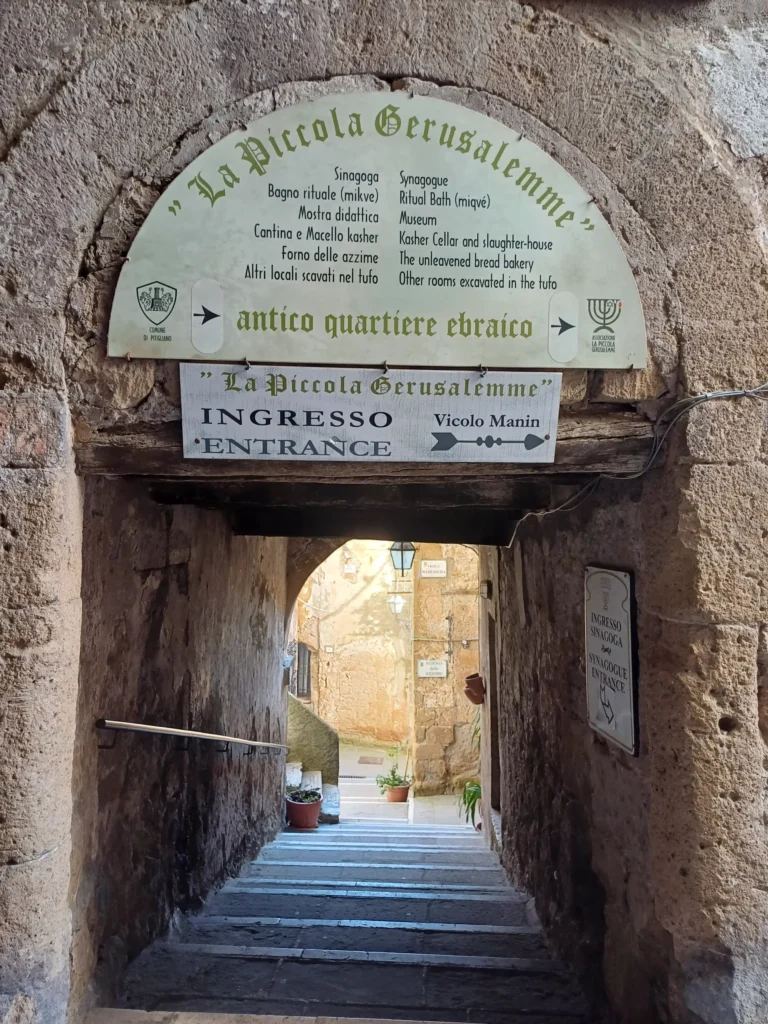
Credit: TuscanDreamVacations.com
The Italian unification in 1861 led to Jewish emancipation, prompting many in Pitigliano to move to larger cities, and leave Pitigliano behind.
In 1938, racial laws forced Pitigliano’s Jewish population to hide in the countryside with the help of the locals.
Today, only a few Jewish families remain in Pitigliano. Its ancient ghetto has since been turned into a museum, serving as an eyewitness account of its turbulent history and heritage.
Dante’s Inferno: How a Medieval Poet Shaped Pitigliano’s History
Prior to my trip for Pitigliano, I researched articles and books about this beautiful town on the web; what I discovered astounded me: Pitigliano had an unexpected link to Dante Alighieri, the creator of The Divine Comedy, whose literary masterpiece remains one of humanity’s enduring classics.
Dante Alighieri was an Italian poet, philosopher, and political activist of the 13th and 14th centuries. He wrote The Divine Comedy to document his journey through Hell, Purgatory, and Paradise. Along the way, he encountered historical and mythical characters such as Count Ugolino della Gherardesca a Pisan nobleman condemned to Hell’s ninth Circle.

Credit: TheCollector.com
What is Dante’s connection to Pitigliano? His connection stems from the Aldobrandeschi family, rulers of Pitigliano, and relatives of the Gherardesca family. Dante meets Count Ugolino Gherardesca in Hell, and later in Purgatory. Dante praises the Aldobrandeschi family for their staunch support of the Emperor Napoleon III and the Ghibelline faction (Dante even refers to Guglielmo Aldobrandeschi as “Grand Tuscan”), which underscores their deep ties.
In summary, Dante’s connection to Pitigliano is woven through historical figures, political allegiances, and familial bonds, making it a fascinating aspect of both literary and local history.
What to see and Do in Pitigliano
Pitigliano invites visitors to discover its narrow streets, ancient buildings, and hidden corners. Here are some key attractions not to be missed during their stay:
The Orsini Palace: Pitigliano’s most stunning building was once home to the Orsini family who ruled from 13th to 17th century. Boasting Renaissance facade, medieval tower, and baroque chapel features, this palace houses its Museum of Orsini Palace which features paintings, sculptures, weapons and furniture from different eras. You can also visit Diocese Museum which showcases religious artifacts from surrounding churches and the Cathedral.
The Cathedral of Saints Peter and Paul: Pitigliano’s main church dates back to 13th century, featuring Romanesque-Gothic style with a simple facade and bell tower. Inside you can marvel at frescoes by Pietro Aldi, Francesco Nasini, Antonio Nasini. Altar pieces, frescoes by many other artists such as Francesco Nasini. It also houses Saint Rocco as patron saint of Pitigliano!
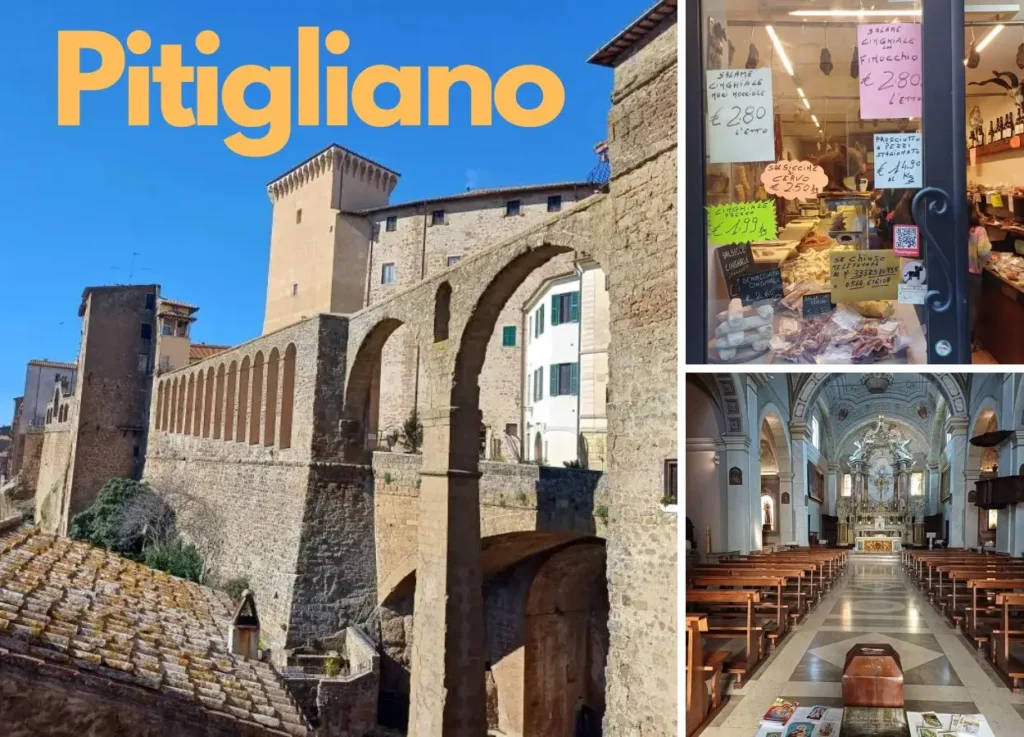
Credit: Tuscandreamvacations.com
The Vie Cave: These are ancient roads carved into the tufo rock by the Etruscans, who inhabited the area before the Romans. These trails connect Pitigliano with other nearby towns, such as Sovana and Sorano, and they are surrounded by a mysterious and enchanting atmosphere. Via Cave are the perfect hiking destination (or trekking, as my European friends call it). Along these routes, you’ll encounter Etruscan tombs, temples, and sculptures, captivating remnants of a great civilianization. 🚶♂️🚴♀️

Via Cave
The Arches: Carosello in Pitigliano is an annual cultural event which unites its community in celebration. As Carosello takes place across various central locations, the arches serve as iconic landmarks that serve to frame local artisans, musicians, and performers for an engaging cultural showcase.

Credit: TuscanDreamVacations.com
In Pitigliano, “Carosello” captures the essence of celebration under its iconic arches, where history meets modern festivity in a charming display of local pride.”Carosello” made waves on Italian television as well, borrowing its name for entertaining sketches during commercial breaks. Similar to Pitigliano’s celebration, this television version also prioritized community and engagement while its visual backdrop of arches recalling Pitigliano’s main square further enhanced the sense of festivity associated with both festivities.
Food and Wine Specialties
Pitigliano is famous for its white wine, called Bianco di Pitigliano, which has a DOC (Denomination of Controlled Origin) status. The wine is made from local grapes, such as Trebbiano, Grechetto, and Malvasia, and it has a dry and fruity taste. You can taste the wine in the many cellars and taverns in Pitigliano or buy a bottle to take home.
Sfratto di Pitigliano: Imagine a pastry that tells a story of survival and courage. That’s what sfratto di Pitigliano is. It’s a Jewish delicacy that dates back to the 17th century when the Jews of Pitigliano were forced to leave their homes and move into a ghetto.
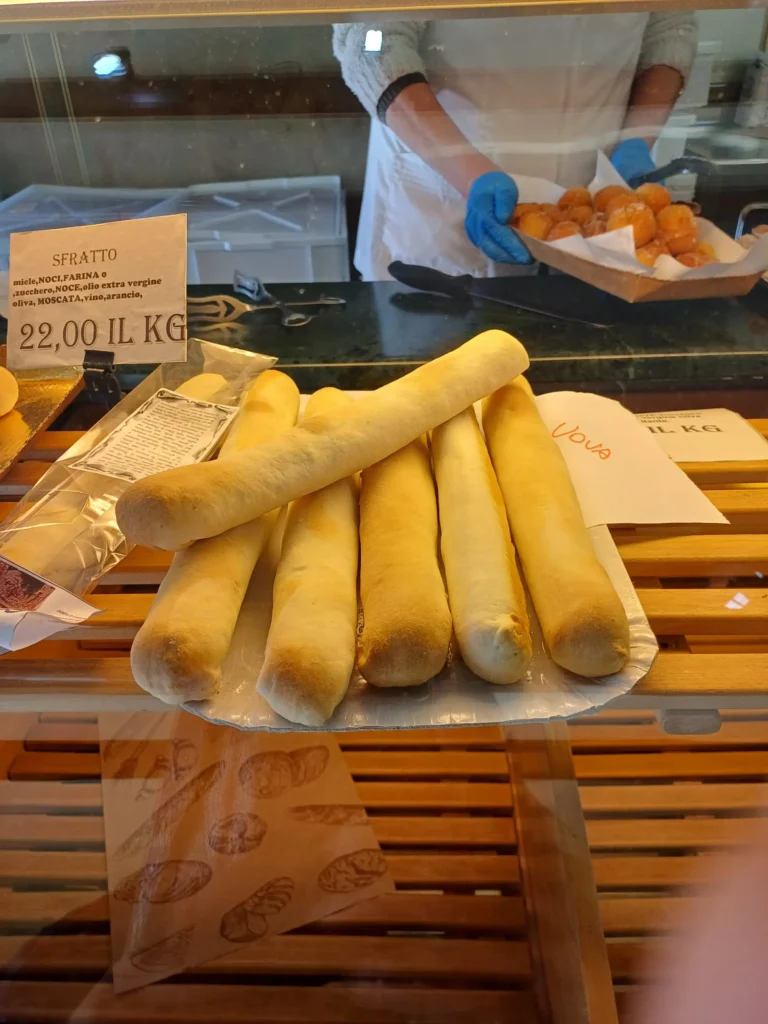
Credit: TuscanDreamVacations.com
The officials would bang on their doors with a wooden stick to warn them they were being evicted. As a tribute to their ordeal and resilience, the Jews of Pitigliano baked this pastry as a reminder. It features a stick-like shape filled with honey, nuts, and citrus peel. It’s crunchy on the outside, but soft and gooey on the inside for a tasty and fragrant treat bridging Tuscany and Israel, through flavors and cultures. You’ll find this treat available in most bakeries and restaurants throughout Pitigliano. 🥮🍯
How to Get There
From Florence: There are a couple of routes when driving from Florence to Pitigliano that you can take. Take Highway A1: From Florence, head southbound on the A1. Follow signs to Rome (Roma); after approximately 130 kilometers, take exit #37 toward Orvieto (Orvieto). Follow local roads from Orvieto to Pitigliano and take in the spectacular Tuscan landscape along your drive! Or alternatively take the State Road 74 directly from Florence. Head south along SS74, passing through towns like Certaldo and Colle di Val d’Elsa on your journey to Siena. From there, follow signs for Grosseto and Pitigliano; although this route takes slightly longer it also offers beautiful sights along its path.
From Siena: When driving from Siena, take the SS2 road which passes through Val d’Orcia and towns such as San Quirico d’Orcia, Pienza and Montalcino for approximately two hours of stunning landscapes: rolling hills, vineyards and cypress trees along your journey. Alternatively, consider taking either of two highway routes: E78 or E80 which offer faster but less scenic travel with journey times around one and one-half hours depending on route chosen.
From Grosseto: If you are taking the bus, you can find direct connections from Grosseto, Orbetello, and Manciano. The bus trip takes about an hour and a half from Grosseto, an hour from Orbetello, and half an hour from Manciano.
Conclusion
Pitigliano is a unique town where you can experience true Tuscany away from crowds and cliches. Pitigliano will charm you with its tufo buildings and trails, beautiful landscapes, and intriguing history. Don’t miss it. If you are a hiker enthusiast, the trails through the neighboring towns will amaze you.
If you have been there, please leave a comment below and share your experience with me!
